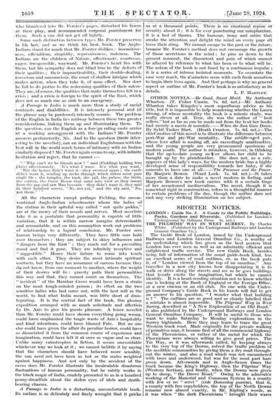SHORTER NOTICES. •
THE PILGRIMS' WAY IN WEST SURREY. By Charles White. (Published by the Underground Railways and London General Omnibus Co.).
The Guide Book- of London, issued by the Underground Railways and London General Omnibus Co., is worthy of an undertaking which has given us the best posters that London has ever seen as well as an admirably efficient and enlightened traffic service. The new Guide Book, besides being full of information of the usual guide-book kind, has an excellent series of road outlines, or, as the book puts it, of " London viewed from the top of an omnibus." Any traveller in a new city knows how disappointing it is to walk or drive along the streets and see as he goes buildings that keenly excite the imagination, but which he cannot identify. It is a heart-rending situation not to know whether one is looking at the Bank of England or the Foreign Office, at a new cinema or an old club. No one with the Under- ground Company's Guide Book in his hands will fail to get an answer to his question, " I wonder what that building is ? "- The outlines are so good and so clearly labelled that a mistake is almost impossible. The Pilgrims' Way in West Surrey, described as " A New Exploration of an Old Road," is also published by the Underground Railways and London General Omnibus Company. It will be useful to those who Want" to snake Satiirday to Monday explorations in the Surrey highlands. Here they may learn to trace the great - Western track road. Made originally for the private walking of primitive man, it became first of all the commercial highway of the Phoenicians, or rather of the metal for which the Phoenicians were always willing to give good prices. The Tin Way, as it was afterwards called, by keeping always to the very top of the Downs, solved the traffic problem of the neolithic communities -by giving them a dry road through- out the winter, 'and also a road which was not encumbered with trees and underwood, but was for the most part bare green down. Afterwards and in Anglo-Saxon times the track became the King's Highway, then the Pilgrims' Way (Western Section), and finally, when the Downs were given up to sheep, " the Drove Road." Owing to the admiralA working of the Manorial and Commons System in a county with few or no " servi " (vide Doniesday passim), that is, a county with free eopyholders, the top of the North Downs remains now almost exactly, in Mr. Kipling's words, as it was when " the dark Phoenicians " brought their wares along the Western road. The little book which we are describing tells you how to get to Pewley Down, via Newlands 'Corner, and -through Hackhurst Downs and the White Downs to Pickett's Hole and Denbies, 'the great chalk bluff above Dorking. The photographic reproductions of 'various points on the Pilgrims' Way are excellent.















































 Previous page
Previous page